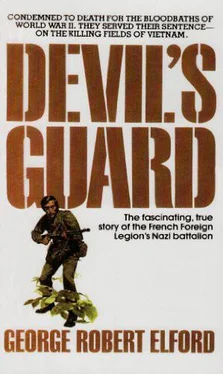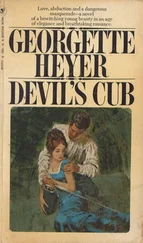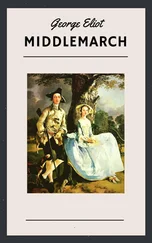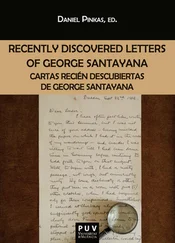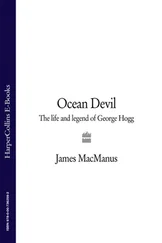After the burial we executed the rest of the prisoners except for a single individual. We needed him for sending a message to the Viet Minh High Command. “Go and tell Giap that he had better study the Geneva Convention about the treatment of prisoners,” I told the guerrilla. “Unless he behaves in the future he will receive similar treatment in every filthy village he has.”
We could find nothing of the corpse of Captain Arnold Lorilleaux.
Walking through the smoking ruins of the Red village, I suddenly remembered Schulze’s words to the guerrilla emissary on the road to Yen Bay: “You may run into the jungle when you see us coming, but beware when you see us leaving. You may find no village to return to.”
After this incident, the Viet Minh placed a reward of 25,000 piasters for the capture of any German of my group. I enjoyed the honor of being valued at 200,000 piasters, with a distinctive “dead or alive” allowance. Afterward Schulze and Eisner would often remark teasingly, “Hans, before we quit the Legion, your price will surely be above a million. We shall bump you off and sell your guts to Ho Chi Minh. Would you kindly remind us-----” Schulze, Eisner, Pfirstenhammer, and Riedl had to be content with a meager 50,000 piasters per head, “An insulting undervaluation,” as Karl put it. “We’ll have to work harder to boost the price,” he remarked wryly.
6. HUMANE AND INHUMANE INTERLUDES
On patrol duty along the Hanoi-Lang Son railway line. Eighty miles there, eighty miles back. Under ordinary circumstances a return trip would not take longer than four hours. We were on the road for the sixth consecutive day, mercifully on the way back and still in one piece. Along the line and at every crossing small bunkers dotted the landscape. Strong platoons patrolled their respective sections. The dominant elevations along the line had been fortified, the forest line cut back to deprive the enemy of cover. At a few particularly vulnerable sections coils of barbed wire stretched for miles. The barren strip of land that bordered the line had been proclaimed off limits to civilians, and unauthorized persons were shot without warning. Large posters in French and in three local tongues warned the population not to trespass in the restricted areas. Legitimate crossings were permitted only at the army checkpoints near a bunker or fortified guardhouse.
The trouble was that a large percentage of the population could not read. Many fatal incidents occurred when old people or children tried to traverse the tracks and were gunned down from a hidden observation post. The guards were jittery. Pulling the trigger was their natural reaction to anything that moved within the restricted area, especially after dusk. All the same, the Viet Minh had managed to blast the line several times and at places miles apart. They had occasionally derailed a train as well.
The road along the tracks was also a principal guerrilla target. Hardly a week went by without a few army vehicles exploding somewhere between Bac Ninh and Lang Son. In order to frustrate the enemy snipers, who preferred to operate at night, our vehicles carried a pair of decoys apart from the standard headlights. The decoys were mounted on thirteen-foot-long steel pipes that we attached to the mudguards as soon as darkness fell. They traveled well ahead of the vehicle, and the first guerrilla salvo would invariably go wild because it was aimed behind the fake headlights where the terrorists thought the engine and the driving compartment should be. The decoys gave us time to switch off all lights and disperse; along the road before the snipers could correct their aim. • The vehicles kept thirty yards apart with an old GMC; truck leading the way, followed by two jeeps with; mounted MG’s, a light armored car, and two troop carriers. We fitted the front of the CMC with a pair of” heavy steel wheels, in line with the front tires but nine feet ahead. The wheels could be raised or lowered on their hinged mounts by the front pulley. They were ordinary--nary transmission wheels which used to drive the machinery of an old mill; heavy enough to detonate pres-; sure mines yet sufficiently solid not to break easily but; rather to lift upward should a charge explode under them. Curved steel plates an inch thick shielded the driving compartment and the tires from fragments. The windshield of the GMC was reinforced with wire mesh and the sides of the truck protected by additional plating. Defense against command-detonated mines was not easy but such mines were also less frequent. We devised a primitive contraption, a sort of narrow-bladed, sturdy hoe which the GMC dragged along the roadside to pick up: the wires of such command-detonated mines. A swivel socket with springs prevented the hoe from breaking when it caught a root or a stone.
Naturally we submitted a report on all our workable “inventions,” many of them old tricks that worked well in Russia and similarly in Indochina. None of them was, ever appreciated, let alone introduced. Our generals were still firmly convinced that the military academy at Saint Cyr had bestowed upon them all the knowledge one; should have about warfare and the descendants of Napoleon should not borrow ideas from the ranks, and especially not from the Germans.
Unfortunately, the last two generals known to have taken part in perilous patrol missions in enemy territory were Rommel and Patton—both now dead. The French generals conducted the war the way they would have conducted it in the forests of France or in the Sahara desert. The jungles of Indochina made no impression on them. They were refined, cultured, and dignified men who; knew by heart every significant work on warfare except: Mao’s doctrine of guerrilla wars. No French officer with-dignity would even touch Mao. For them the jungle meant only a sort of overgrown Bois de Boulogne, and guerrilla warfare was only guerrilla warfare.
The woman who waved down our jeep was standing on the roadside shading her eyes from the searchlight. She wore a shabby workman’s overall fastened with a thin belt around her waist and crude rubber sandals. A small paper bag lay beside her in the grass. When I stopped she walked up to the jeep and wiping the loose hair from her forehead she said hesitantly, “Excuse me, officer, are you going to Hanoi?” She spoke educated French but her voice sounded weary.
“Yes, we are.”
I nodded, eyeing her with mixed feelings.
“May I come with you? I am very tired.”
I looked at Riedl and he said in German, “She isn’t Veronica Lake but let her come. I will check her bag.”
“Do you carry any weapon?” I asked her, feeling a little awkward the moment I spoke.
“Me?” she exclaimed with wide open eyes. Then she shook her head and replied with a smile, “Oh, no, monsieur. I am not fighting the French Army.”
Her last words caught my attention for native Indochinese would have said “Legion,” not French Army. I helped her aboard.
“Thank you,” she said, “may I put my bag in the rear?” Riedl took her bag and glanced into it. “I hope you don’t mind, but we have certain regulations.”
The girl did not mind.
“Thank you very much,” she repeated. I gave the word to move on.
For some time there was silence between us. She was probably a middle-class refugee, I thought, remembering her cultured French. We were accustomed to natives trying to thumb a ride and had our orders not to pick up anyone. There were too many pitfalls; not only the wartime Japanese but the Viet Minh, too, had its kamikaze squads. We had just heard of a young terrorist who had been given a ride on an ammo truck—gross negligence on the part of the guard. The passenger had been a quiet little boy who told a sad story about his family having been tortured and executed by the Communists in Cambodia, and about his long way across the jungle^ He had said that he wanted to join the army and avenge the death of his family. The troops had been impressed; they had given him food, money, and friendly advice.
Читать дальше
